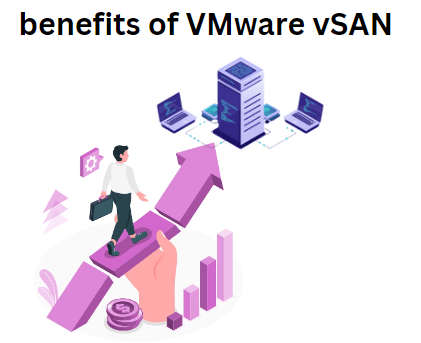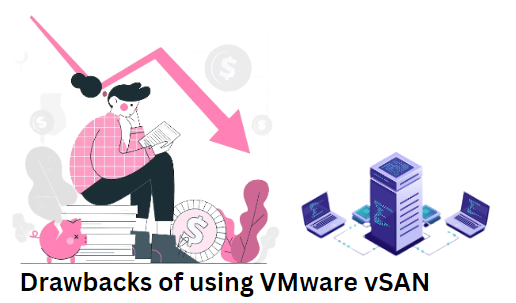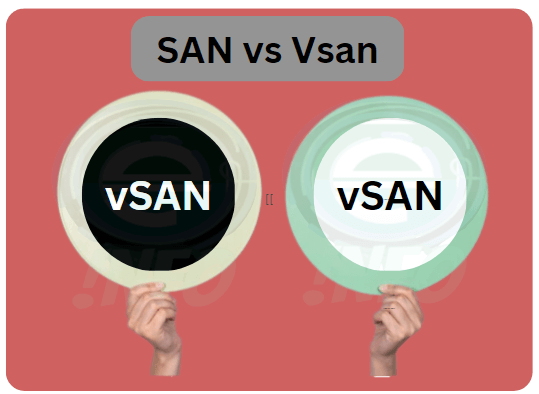In today’s article, you will learn about What is VSAN in VMWare, the benefits of VMware vSAN, the Drawbacks of using VMware vSAN, and the advantages and disadvantages of using VSAN VMware, SAN vs vSAN
Table of Contents
what is vSAN in VMware
vSAN, or VMware vSphere Virtual SAN, is a software defined storage solution that is integrated into VMware’s vSphere virtualization platform. By facilitating the development of a robust and expandable storage infrastructure, vSAN can support virtualized workloads with high availability.
vSAN uses local storage resources on the physical servers in a vSphere cluster to create a distributed storage system.The storage resources allocated by ESXi may include hard disk drives , solid state drives , or PCIe-based flash devices. The storage resources on multiple servers are combined to form a shared datastore where virtual machine files and data can be stored.

vSAN provides several features such as data protection, data efficiency and data resiliency. ESXi provides a user-friendly management interface that enables administrators to easily monitor and manage their storage infrastructure within the vSphere environment.
vSAN delivers a flexible and cost-effective solution for storage provision to virtualized workloads, negating the requirement for additional hardware or specialized storage equipment.
benefits of VMware vSAN
Let’s explore the advantages of VMware vSAN.

- Scalability: vSAN allows you to scale your storage infrastructure as needed by adding additional hosts to your cluster. This makes it easy to grow your storage infrastructure without having to invest in expensive specialized storage equipment.
- High Availability: vSAN creates a distributed storage system that is highly available and resilient to hardware failures. It provides redundancy at the disk and host level, so if one host or disk fails, your virtual machines (VMs) continue to operate without interruption.
- Performance: vSAN leverages flash-based storage to deliver high-performance storage to virtualized workloads.It also supports features like Quality of Service to ensure that critical workloads get the storage performance they need.
- Cost-Effective: vSAN eliminates the need for specialized storage equipment, which can be expensive to purchase and maintain.vSAN’s implementation can also minimize the necessary hardware required to maintain virtualized workloads, resulting in reduced power and cooling expenses.
- Simplified Management: vSAN is integrated into the vSphere management platform, providing a single interface to manage your storage and virtualization infrastructure. This makes it easy to provision, monitor and troubleshoot your storage infrastructure.
- Flexibility: vSAN is supports with a variety of storage devices such as hard disk drives, solid state drives and flash devices based on NVMe. It also provides flexibility in terms of deployment options, including hybrid and all-flash configurations.
overall vSAN presents a potent, easily scalable and reasonably priced storage solution for virtualized workloads. vSAN streamlines management, while maintaining high performance and availability, and its flexible configuration can cater to the diverse requirements of various workloads.
Drawbacks of using VMware vSAN
Here are some potential drawbacks of using VMware vSAN:

- Hardware requirements: In order to function appropriately vSAN mandates specific hardware elements such as solid state drives or NVMe drives for caching and hard disk drives for capacity. This can limit hardware flexibility and increase costs for organizations that do not have the necessary hardware.
- Complexity:Implementing and managing vSAN can be complex especially for organizations that are not familiar with virtualization and storage technologies. This can require additional training and resources to manage and maintain the vSAN environment.
- Performance impact: Depending on the configuration and workload, vSAN can have a performance impact on the host servers. This can be mitigated by using hardware with high performance and by tuning the vSAN configuration appropriately.
- Licensing costs: vSAN is licensed separately from vSphere, which can add to the overall cost of the virtualization infrastructure. Additionally, licensing costs can increase as more hosts are added to the vSAN cluster.
- Dependency on vSphere: vSAN and vSphere are closely interwoven implying that businesses that want to employ vSAN must also employ vSphere as their virtualization platform. This can limit flexibility and increase vendor lock-in.
Overall while vSAN offers many benefits it is important for organizations to carefully consider the potential drawbacks and ensure that it is the right storage solution for their specific needs and requirements.
Know about SAN vs Vsan
SAN Storage Area Network and vSAN Virtual SAN are both storage solutions but there are some key differences between them.
SAN is a specialized storage network that interconnects servers and computing devices with a series of storage devices. It is typically a separate network that is dedicated solely to storage and is managed by a separate team of IT professionals. SAN can be leveraged to manage and store significant volumes of data, while also sustaining high-speed data transfer rates.
vSAN is a software defined storage solution that is built into the VMware vSphere hypervisor. It uses local storage resources on each server in a cluster to create a distributed storage system that is managed as a single entity. vSAN can be used to create a highly available and fault-tolerant storage infrastructure and can also support the use of flash storage for improved performance.

Primary differences between SAN and vSAN are as follows
- SAN is a physical storage network, whereas vSAN is a virtualized storage network.
- SAN requires dedicated hardware components such as storage switches, controllers and host bus adapters (HBAs) while vSAN uses standard server hardware with locally attached storage.
- SAN typically requires a separate team of storage administrators to manage it, while vSAN can be managed by virtualization administrators.
- SAN can support a wide range of storage technologies including Fibre Channel, iSCSI and FCoE, while vSAN only supports storage connected directly to the servers in the cluster.
FAQ: VSAN in VMWare
vSAN VMware full form
vSAN stands for Virtual Storage Area Network, a software defined storage solution built into the VMware vSphere hypervisor.
VMware vSAN pricing calculator
VMware vSAN pricing calculator is a tool that allows customers to estimate the costs of purchasing and deploying vSAN. It takes into account factors such as the number of hosts, the amount of storage required and the licensing options chosen to provide an estimated total cost of ownership for the solution.
VMware vSAN Architecture
VMware vSAN is a distributed storage architecture that aggregates local storage resources from multiple hosts into a single shared datastore. It uses a policy based management framework to provide automated storage provisioning and management and supports a wide range of storage features including deduplication, compression and encryption.
You May Also Like:
want to know more about vSAN please go through official website Vmware


6 thoughts on “VMware: What is VSAN in VMWare”